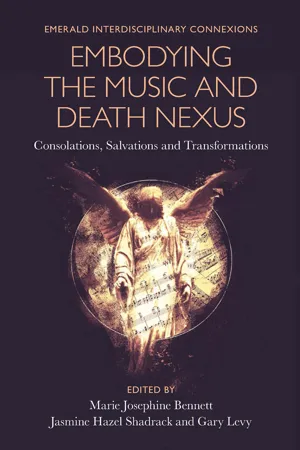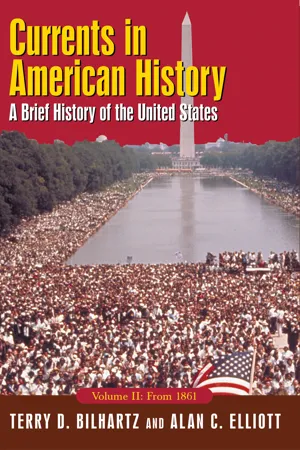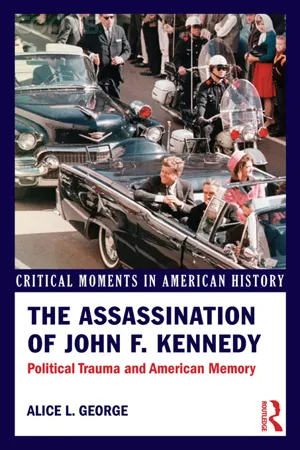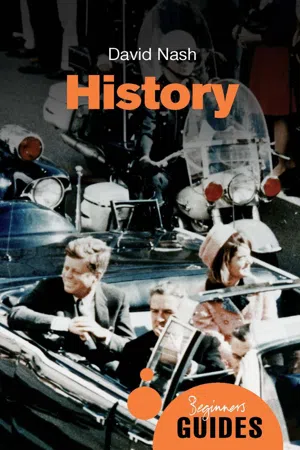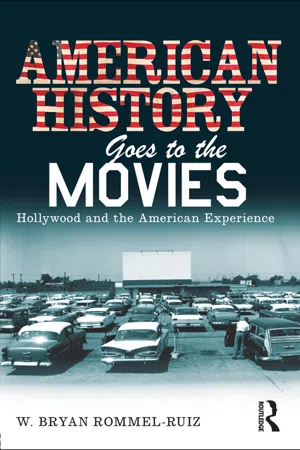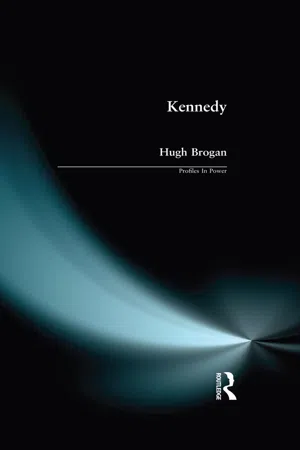History
Assassination of JFK
The assassination of JFK refers to the tragic event on November 22, 1963, when President John F. Kennedy was shot and killed in Dallas, Texas. Lee Harvey Oswald was arrested for the crime but was himself assassinated before standing trial. The event had a profound impact on American society and politics, leading to widespread conspiracy theories and ongoing public fascination.
Written by Perlego with AI-assistance
Related key terms
Related key terms
1 of 4
Related key terms
1 of 3
10 Key excerpts on "Assassination of JFK"
- eBook - ePub
Embodying the Music and Death Nexus
Consolations, Salvations and Transformations
- Marie Josephine Bennett, Jasmine Hazel Shadrack, Gary Levy, Marie Josephine Bennett, Jasmine Hazel Shadrack, Gary Levy(Authors)
- 2022(Publication Date)
- Emerald Publishing Limited(Publisher)
2018 ). Notably, regarding the activities of a political leader, their role is strongly influenced by contextual factors and always requires flexible action. As Gabriel Sheffer argues on the nature of leadership:In addition to personal attributes, leadership is intimately related to the fabric of the leaders' relevant societies, to social and political organizations, to established institutions, and to leaders' relations with smaller and larger groups of followers.(Sheffer, 1993 , p. vii)Consequently, a leader tends to adapt to a particular situation by choosing the most functional modes of action which may provide effectiveness (Berg & Rao, 2006 ; Elgie, 2018 ; Helms, 2012 ).In this context, the role of the American president during the Cold War was of particular significance (Lightbody, 1999 ). As David Kaiser (2008) argues, JFK's assassination can be interpreted as an element of the political game the US internal official (CIA) and unofficial (organised crime in the United States) institutions played with external services (Fidel Castro's Cuba, the USSR under Nikita Khrushchev), blaming the communists for indoctrinating Lee Harvey Oswald efficiently in their anti-American ideology (Kaiser, 2008 , p. 189). Thus, in this period, the US president stood as a symbol of the forces of Western democracy, engaged in an ultimate ideological dispute with the undemocratic East.In this context, the figure of JFK can be helpful from today's perspective to build a mythological context of national politics: he was incorporated in the pantheon of figures significant for culture and politics as a martyr of issues that have gained particular importance for Western societies over the twentieth century. Such problems as the issue of racial and social equality, overcoming segregation and the moderate resolution of political conflicts serve as elements that built JFK's legend in both political and pop-cultural domains. Undoubtedly, the assassination of the president became a vital reference point in contemporary American history, and it seems that it also influenced the collective imagination, not only in the United States, but also in the entire Euro-Atlantic region. Also, for Eastern European people behind the ‘Iron Curtain’, JFK appears to be a symbol of a fighter against enemies regardless of his actual characteristics. In addition, thanks to the intensive use of his persona in popular culture (including films, photos, songs, or musical works), JFK has become a symbol of American life: success, courage, physical attractiveness, which has permanently embedded him in the sociocultural imaginary of the past century. - eBook - ePub
Currents in American History: A Brief History of the United States, Volume II: From 1861
A Brief History of the United States, Volume II: From 1861
- Alan C. Elliott, Terry D. Bilhartz(Authors)
- 2023(Publication Date)
- Routledge(Publisher)
Other theories speculate that Castro was involved in the assassination. Others suggest that it was anti-Castro Cubans, not pro-Castro ones, who cooperated in an assassination conspiracy. Still others speculate that organized crime was involved. No matter how the riddle of the assassination is solved, the murder of John Kennedy remains a tragic example of the intrigue and intensity emblematic of the Cold War era.The sudden death of the young husband and father plunged the nation into mourning. As Jackie Kennedy remarked, “There'll be great presidents again… but there'll never be another Camelot.” Americans still sang the Broadway song composed by Kennedy's friend Alan Lerner, but now it was the final stanza that captured the sullen national mood that followed Kennedy's death:Don't let it be forgotThat once there was a spotFor one brief, shining moment that was known as Camelot.The Political Consequences of Kennedy's Death
The moment radio and television announced the death of the president, the political landscape of the nation shifted. The impact of this etched-in-the-mind turning point in American history served as a haunting reminder of the heart-stopping mental nausea following the attack on Pearl Harbor. In the same way the surprise attack in Hawaii silenced the isolationists and united the nation in a war crusade, the shock of the assassination silenced Kennedy's outspoken critics and gave impetus to the promised reforms of the New Frontier. As large as he was in life, the Kennedy mystique grew even larger in death. Years later, historians would write about the “darker side of Camelot,” including the president's extramarital affairs, but these stories were unknown or irrelevant to the great majority of Americans in the 1960s. In the aftermath of the assassination, Kennedy was viewed by most Americans as a noble knight who was willing to sacrifice himself for noble causes.Lyndon Johnson also deserves much credit for what took place in Congress during the months that followed Kennedy's death. An experienced and shrewd southern Democrat himself, Johnson told the grieving nation that “the ideas and ideals which [Kennedy] so nobly represented must and will be translated into effective action.” He promptly went to work, asking Congress to reduce personal income taxes by $10 billion ($66 billion in today's currency) and to approve an uncompromising civil rights bill. The latter bill would prohibit discrimination based on race, color, religion, sex, or national origin in employment and public places and create an Equal Employment Opportunity Commission (EEOC) to ensure the enforcement of the law. The tax law came quickly and was signed by Johnson early in 1964. Securing civil rights legislation took more work. Joining with the NAACP, the AFL-CIO, the National Council of Churches, and the American Jewish Congress, President Johnson launched an intensive lobbying campaign in Congress. The six-foot four-inch Texan used his towering size and the power of the presidential office to cajole, flatter, and, if necessary, threaten key members of Congress. His persistence paid off. In July, Johnson signed the Civil Rights Act of 1964, the most comprehensive civil rights package passed since Reconstruction. - eBook - ePub
The Assassination of John F. Kennedy
Political Trauma and American Memory
- Alice George(Author)
- 2012(Publication Date)
- Routledge(Publisher)
In the coming years, Vietnam and Watergate deepened the average American’s cynicism about hidden plots and dishonest government, making it seem quite logical to distrust official explanations of the assassination. By 1967, the scales already had tipped, with the majority of Americans expressing reservations about the single-gunman theory. Doubts about government’s honesty only intensified following two big events in the early 1970s—the 1971 publication of the Pentagon Papers, which revealed the Johnson administration’s Vietnam secrets; and Richard Nixon’s 1974 resignation when evidence revealed that he was, after all, a crook. With faith in government making a steady decline since the Kennedy years, Stone’s 1991 assassination conspiracy film JFK met a receptive audience. Even before this landmark work, American popular culture had transformed the slain president’s death in many ways that challenged the boundaries of good taste. One example: John F. Kennedy Jr.’s then-girlfriend Daryl Hannah appeared on a 1993 Spy magazine cover wearing a sexed-up suit similar to the one Jacqueline Kennedy wore on the day of his father’s assassination. And, in 2004, a video game was introduced that allowed players to assume the assassin’s role and shoot the president, like a target in a county fair shooting gallery. Somehow, conspiracy belief found a home within this morbid assassination culture. Fascination with the crime grew. In the wake of hurried and error-riddled government investigations, conspiracy theorists spun often-implausible, thoroughly complex tales. The exploding head of the handsome prince became a single image in a compellingly blood-spattered American whodunit - eBook - ePub
History
A Beginner's Guide
- David Nash(Author)
- 2015(Publication Date)
- Oneworld Publications(Publisher)
3 The search for ‘truth’ – establishing the facts, causes, and explanationsThe assassination of John F. Kennedy
On 22 November 1963 the president of the USA, John F. Kennedy, was assassinated whilst visiting the city of Dallas, Texas. He was shot at approximately 3 PM , in the presence of his wife and a number of his close aides and advisers, as he was travelling in a presidential motorcade.It is a salutary comment that, in the final analysis, this is all we can know for absolute certain of what actually happened to John F. Kennedy on that fateful afternoon. Almost all those who have read this far will certainly be concerned that this explanation is not complete or in any way satisfying. It does not contain important information that we would want to establish as fact or explanation, something that would enable us to analyse the events of that day with greater precision and accuracy. The need for such undisputed facts and a desire for the truth is one of the very strongest reasons that human civilization has for wanting a sophisticated and developed conception of history. Without this, simply retelling the events risks making this account nothing more than an unsatisfactory story.This search for the truth is fundamental to us in moulding our conception of how life and events are given order and made to have meaning. Thus truth, trust in the facts, and the power of interpretations are what often enable individuals to cope with the world and shape their conceptions of good and evil. History is a search for truth, even if it is sometimes approached from some very different and contrasting directions. What we perceive the truth to be (drawing on facts we know and the interpretation we favour) also shapes the narrative that we give to history. As a result, many of the ideas about history that shape our lives rest on the establishment of these facts and fundamental truths. The search for the truth, as von Ranke argued, fundamentally drives the need to give shape to history. The consequence of this is that a historian strives for the truth to ensure that the history they write has the correct shape and tells the correct story. Thus an individual history written by an individual historian seeks to portray their version of the truth as a combination of their ability to prove a series of facts and shape these into an interpretation. - eBook - ePub
Conspiracy
The Greatest Plots, Collusions and Cover-Ups
- Charlotte Greig, Mike Rothschild(Authors)
- 2020(Publication Date)
- Arcturus(Publisher)
MURDER MYSTERIESWHO SHOT JFK?FROM AGATHA CHRISTIE’S genteel criminals, to the more graphic detective novels of the twenty-first century, a good murder mystery is the book of choice with which to curl up in an armchair for millions of people the world over. And if that murder mystery involves celebrities, sex, politicians, and may in fact be true, that only serves to make it all the more enjoyable!The assassination of John F. Kennedy on 22 November 1963 has generated more conspiracy theories than almost any other crime in history. This is partly because the crime was such a shocking, dramatic event. As we all know, the president was fatally shot in full view of the public while riding along in an open-topped motorcade, with his wife beside him. But it is also because the hastily assembled Warren Commission, set up just one week after the assassination for the purpose of enquiring into what happened, failed to account for the many perplexing aspects of the crime. The Commission found that a lone gunman, Lee Harvey Oswald, had fired three shots at the president. The first of these missed the motorcade; the second wounded both Kennedy and the Governor of Texas, John B. Connally, who was also riding in the limousine; and the third and final shot hit Kennedy in the head, killing him.The related conspiracy theories became known as ‘The Lone Gunman Theory’ and ‘The Single Bullet Theory’ (often jokingly referred to as ‘The Magic Bullet Theory’ because it seemed so unlikely that one bullet could penetrate two people). In time, both theories came to be regarded as highly implausible – not only by the experts but by the majority of the American public, who were polled on numerous occasions in order to obtain their opinions on the matter.To compound the confusions, on 24 November 1963 Jack Ruby, a Dallas nightclub owner, shot Oswald dead while he was in police captivity. Once again, the killing took place in full view of the public. The event prompted a new wave of speculation. How was it that Ruby had found it so easy to flout the tight security surrounding Oswald? Had Oswald been swiftly executed in order to prevent incriminating evidence being brought against establishment figures at the trial? And what about Ruby’s links to the world of organized crime? Was the Mafia involved in some way with Kennedy’s death? Ruby swore that he had been acting on his own, in revenge for the killing, but many disbelieved him. By the time he died of a stroke on 3 January 1967, his motives were still thought by some to be questionable. - eBook - ePub
American History Goes to the Movies
Hollywood and the American Experience
- W. Bryan Rommel Ruiz(Author)
- 2011(Publication Date)
- Routledge(Publisher)
Libra we need to examine how the conspiracy theories surrounding the Kennedy assassination operate as stories with a particular logic and resolution that address the tension, complexities, and emotionality inherent in this historical tragedy.JFKand the Tension between History and NarrativityNot since The Birth of a Nation has a movie provoked so much controversy about the relationship between film and history as Oliver Stone’s JFK . While the film engendered wide-ranging discussions among the American public at the time of its release in 1991, academics from a variety of disciplines have also participated in these dialogues, and continue to engage the film from multiple perspectives.55 In fact, one of the central issues remains the positionality and subjectivity of Oliver Stone as the primary filmmaker and author of this historical film. Where historians may be quick to identify him as the principal author and therefore putative historian of this cinematic text, narrative theory reminds us that such overt identification between author and narrative is misleading. Even if we recognize Stone as the implied author (as some narrative theorists would suggest) we still have to account for the collaborative nature involved in film production.56 Films reflect numerous authorial voices, from directors, screenwriters, producers, cinematographers, to studio executives, among others, and determining any principal authorial intentionality in the narrative remains elusive. Thus, we should resist identifying Oliver Stone as the “historian” representing and interpreting the history of the Kennedy assassination in the film. Nevertheless, we can still interrogate the movie as an historical text with a narrative sensibility influenced by multiple authors, and examine how it represents history in the ways academics traditionally associate with the practice of historical scholarship. Indeed, the film provokes us to consider it in this vein. While some scholars contend that JFK reflects postmodern history, the film is actually grounded in a modernist epistemology, recalling the positivist tradition in American historiography. As a film, JFK - eBook - ePub
- James N. Giglio(Author)
- 2006(Publication Date)
- University Press of Kansas(Publisher)
11 What has made assassination writers with a conspiracy bent so paranoid, they contend, is the cold war, which caused the CIA and FBI to withhold information about the Kennedy administration’s secret activities in Cuba, including attempts to assassinate Castro. Several conspiracy scholars, of course, have viewed this as an establishment-devised cover-up of a Cuban-directed conspiracy resulting in Kennedy’s death.Even though the probability of a conspiracy is even more doubtful than it was in 1991, the Kennedy case is far from being closed. Questions still remain about Oswald, even though he was likely the primary assassin: Was he encouraged by others who wanted the president dead? Or was he a sociopath acting alone for personal or political reasons? There is still some doubt about the super bullet, including the implausibility that it wounded both Kennedy and Connally. Evidence from the Zapruder film seems to show Connally’s delayed reaction to being hit in relation to Kennedy’s response.12 Also in dispute is whether Kennedy might have been hit simultaneously from the front, as an analysis of his head wound seems to suggest. Still questionable, too, are Posner’s and the Warren Commission’s explanations for Jack Ruby’s actions. The irony still remains that a commission so flawed in its investigations might have gotten it right in its conclusions.Regardless, Kennedy’s sudden and tragic death contributed immensely to the romantic way in which Americans would remember his presidency, especially since it preceded violent social conflict, disillusionment, and the assassinations of Malcolm X, Martin Luther King Jr., and Robert Kennedy. To many Americans, John Kennedy’s death ended an age of excellence, innocence, hope, and optimism. It was as if his murder “opened some malign trap door in American culture, and the wild bats flapped out.”13 - eBook - ePub
Growing Up in a Land Called Honalee
The Sixties in the Lives of American Children
- Joel P. Rhodes(Author)
- 2017(Publication Date)
- University of Missouri(Publisher)
Within a horrific matter of seconds, a sequence of high-powered rounds from an assassin’s Italian bolt-action rifle struck the young president, the sharp crack of its discharge reverberating off the tall business district walls through American history. The assassination of John F. Kennedy is the second—albeit obviously the most pronounced—of what psychologists refer to as a “flashbulb memory” in the lives of sixties era preadolescents. So exceptionally emotional was the reaction to the president’s death that the event was mentally captured with freeze-frame-like clarity and a half-century later can still be summoned with remarkable detail. Those who were adolescents and adults on November 22, 1963, can usually tell you exactly where they were at the time, as can many who were children. For the youngest, these recollections are especially complex, because as one of their earliest memories, if not the first, the death of Kennedy also often brought the first real taste of grief, a consuming emotion that stretched a child’s developmental capacities.When Americans talk about remembering the Kennedy assassination, what most really mean is how they first heard that the president had been shot from a friend, coworker, teacher, or news broadcast, and then how they experienced the memorial ceremonies on television. Although the grainy 8mm images of bystander Abraham Zapruder’s color home movie have since provided the nation’s choppy mental visualization of the awful series of events—the final bullet’s violent impact, a blood-splattered Jacqueline scrambling across the back seat, Secret Service agent Clint Hill leaping onto the trunk of the limousine speeding toward Parkland Hospital—no Americans outside of the grassy area where Main, Elm, and Commerce streets converge under a railroad overpass in Dallas actually witnessed the assassination. There was no footage available in real time, and even if there had been, only housewives and preschool children (and students home from school sick) would have been near a television to see it. Yet, by the time Air Force One carrying President Johnson and Kennedy’s coffin arrived back in Washington, D.C., 92 percent of the population had heard, as news traveled across the country, Newsweek magazine said, like a “shock wave.”1 - eBook - ePub
- Daniele Ganser(Author)
- 2023(Publication Date)
- Skyhorse(Publisher)
1Vice President Lyndon Johnson was on the plane too. He was sworn in as the new president of the United States while still in flight. In a coup d’état that lasted only six seconds, Johnson had ascended to the top of the executive branch without a popular election. The power elite knew that imperial policies were much more implementable with Johnson, and he did not disappoint the power elite. President Johnson escalated tensions with Vietnam and sent more than two million US troops to Southeast Asia. After Kennedy’s assassination, the US sank into shock and mourning. Kennedy only lived to be forty-six, leaving behind a young wife and two young children. In Europe, too, people mourned the unscrupulous murder of the young, handsome, and charismatic president. In Berlin, acting mayor and later German Chancellor Willy Brandt said, “A flame has gone out for all the people who hope for peace, justice and a better life. The world has become much poorer this evening.”2The Fairy Tale of the Mad Lone Perpetrator Lee Harvey OswaldLike the events of Pearl Harbor and 9/11, the assassination of President Kennedy is one of the key occurrences in American history. Countless books have been published on the subject. That President Kennedy was assassinated is undisputed. That he was not strangled, poisoned, or stabbed, but shot, is also beyond doubt. What is disputed in historical research, however, is the question of whether Kennedy fell victim to a conspiracy involving several gunmen or whether a crazed lone gunman shot the president. This is the first question that every researcher must answer when dealing with the President Kennedy’s assassination. If he was shot by a crazed lone perpetrator, then it was not a conspiracy, for a single individual cannot conspire with himself. If two or more shooters shot Kennedy on behalf of third parties, then it was a conspiracy because the shooters and principals had to conspire in secret beforehand. - It was too much to hope for. Kennedy’s murder had been too shocking; in the best of circumstances many Americans (including zealous journalists and historians) would have found it impossible to accept that so great an event could have such trivial causes as the odious personality of Lee Oswald and the absence of a Secret Serviceman from the rear of a presidential limousine. But it was not the best of times. The main notes of the Kennedy administration, as it had gradually developed, had been activism at home and abroad, and détente with the Soviet Union - but not with the communist world at large. Lyndon Johnson faithfully continued these policies, and they all backfired on him. He followed up the Civil Rights Act of 1964 with the Voting Rights Act of 1965, thus crowning the work of the non-violent civil rights movement; but it was soon clear that these great achievements were not enough, and that huge social and economic problems, loosely but unbreakably connected with race, still had to be confronted. The mid-1960s were the years of the ‘long, hot summers’ when rioters in the urban ghettos burned and sacked their miserable surroundings in quasi-revolutionary fury, while the white South seethed with fury at its loss of command. The grand Democratic coalition of North and South, city and country, working-class and middle-class liberals, Blacks and Jews, began to fall apart. And the quest for international stability plunged the United States ever deeper into the war in Vietnam. The Johnson administration was forced on to the defensive, and in the dreadful year 1968 - the year of the murders of Martin Luther King and Robert Kennedy, the year of the greatest riots yet, when the Chicago West Side and parts of Washington, DC, were sacked, the year of the Tet offensive and the violent debacle of a Democratic presidential convention - it was finally defeated. LBJ did not offer himself for re-election and Richard Nixon defeated Hubert Humphrey, thanks to the defection of large numbers of Democrats to the third-party candidacy of George Wallace. During the Nixon administration (1969–74) things, if possible, got worse, culminating in the extraordinary Watergate affair.So it is no wonder that many of those who endured the bitter disillusionment of those years, when the US government too often seemed to be wedded to injustice, chicanery and corruption, should begin to question not merely the official explanation of the Kennedy assassination but the accepted account of the Kennedy administration. Lyndon Johnson, it seemed, had systematically deceived the American people; Nixon was a liar without shame. If this was the state of democratic government in 1974, what reason was there to believe that it had been any better eleven years previously, or that Jack Kennedy was superior to his successors? American republicanism was a fraud, manipulated by politicians, generals, big businessmen, organised crime and such sinister institutions as the FBI and CIA for their own ends. In this frame of mind the revisionists got to work.Assassination theorists got most of the attention. Belief in conspiracies of one kind or another has always been strong in the United States, being attractive as a means either of understanding reality or of evading it. The zeal of the first American revolutionaries had been fed by a belief in a conspiracy between the British and their tools in New England; contending beliefs in an abolitionist conspiracy and one by ‘the slave power’ largely brought about the Civil War; belief in a Red Peril had all too great an influence on the politics of the twentieth century. None of these alleged plots are now acknowledged by historians; as myths they are among the many aspects of the past which need explanation and interpretation. So it is with the Dallas conspiracy; but in spite of its impalpability it carried all before it for a long time.
Index pages curate the most relevant extracts from our library of academic textbooks. They’ve been created using an in-house natural language model (NLM), each adding context and meaning to key research topics.
Explore more topic indexes
Explore more topic indexes
1 of 6
Explore more topic indexes
1 of 4
